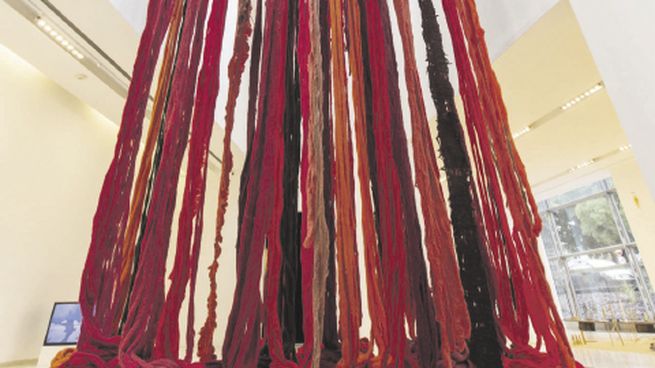The museum broke the historical record of more than half a million visitors.
Cecilia Vicuña “Menstrual quipu (The blood of the glaciers)”.
He malba has just closed a difficult year for Argentines with the historical record of more than half a million visitors, a high figure if you take into account that, except for one free day, the rest have an entrance fee. The season opened with the exhibition “From heaven to home. Connections and intermittencies in Argentine material culture”, an exhibition dedicated to exploring the variety of around 600 Argentine “things” (objects, pieces of art, designs and documents) that, once gathered, ended up configuring a feeling of community belonging. With a nostalgic crush to the heart”, each chosen object attracted visitors from different generations and from all over the country, in addition to foreigners. Meanwhile, in Last August another successful exhibition was inaugurated.
The content you want to access is exclusive to subscribers.
Nobody wanted to stop visiting “There will be none like it”, the meexhibition anthology of Edgardo Gimenezone of the great artists of the Argentinian pop. In addition to his aesthetic qualities, Giménez stands out for the diversity of disciplines that he masters, from painting and sculpture to architecture, furniture and objects; the posters, the scenography and an expansive personality, always with the right word to explain the meaning of the art. The deployment of more than sixty years of production with around 80 works and installationsattracted the malba a public delighted to visit its famous obelisks, wild animals, hearts, monkeys, stars, clouds, rainbows and scenery. “I still am “excited with the public response”. Pop began to close the abyss that at some point opened between life and art. By breaking with exclusivism and “humanizing” its message, Pop arouses a still growing interest in large sectors of the population. Today, for pleasure or curiosity, the public attends art exhibitions en masse..


The last month of the year reached Malba, from the National Museum of Fine Arts of Santiago de Chile“Dream about watera retrospective of the future (1964-…),” the most extensive exhibition to date of the Chilean Cecilia Vicuna (1948), winner of the Grand Prize of the last Venice Biennale. The Vicuña exhibitionpoet, visual artist and political activist, will be at the malba until February 26, 2024 and then will march to the Pinacoteca de San Pablo. The curator Miguel Lopez selected around 200 works made over the last 60 years, including paintings, drawings, texts, silkscreens, collages, textiles, videos, photographs, installations, object books, documents and sound performances. “The sample updates Vicuña’s commitment with popular struggles, respect for human rights and the importance of opposing devastation; “It rescues pre-Columbian textile memory, feminist struggles and eroticism, as well as the demands for self-determination of indigenous communities,” Miguel López highlights during the tour. The games with words and the images that represent them, testify to the ingenuity and messages that the artist is interested in transmitting, who walks through the exhibition with an outfit reminiscent of indigenous people and her long braids surrounding her head. .
The most attractive sector of the exhibition is dedicated to the Quipu, Quechua word that means ‘knot’, and is a type of writing. Upon entering the Malba you can see the double height of the lobby and there it is, from the ceiling to the floor, the lowest level of the museum, the imposing red installation, “menstrual quipu (The Blood of the Glaciers)”, created by Vicuña in 2006, as a way to express his support for Michelle Bachelet, the first female president of Chili. “The liberating power of words is what is longing to be born. And the only way it can be born is through collective acts. Acts that I consider quipus. (…) The Andean peoples conceived the inscription as a knot that could always be undone. Like a knot that was a sign, a knot that was an umbilical cord with the cosmos, with the earth and with water,” concludes the artist.
Acquisitions and Donations 2023
Three new works of indigenous art expand the Malba Collection thanks to the Acquisitions Committee, which this year managed to raise $300,000. These are works by Jaider Esbell (born in Terra Indígena Raposa Serra do Sol, Brazil), the Lima artist Venuca Evanán and the Mayan-tz’utujil artist (Guatemala) Antonio Pichillá. In addition, pieces by eight Argentine artists and one Paraguayan artist are added thanks to private donations.
Maria Amalia Garciachief curator of Malba, points out about indigenous art: “In the last five years, there has been an opening of the contemporary circuit that implied, among other issues, the entry of these demonstrations. This transformation involves a radical change in the appreciation of the cultural production of these communities: their inscription is no longer given by the historical representation made by Western art of the native populations, but rather it is the indigenous artists themselves who present their worldviews based on of productions that articulate ancestral traditions and contemporary languages.” Elena Nofal, Director of Development, observes: “Every year the challenge of living up to the commitment is renewed with Latin American art and with the growth of the museum, managing to incorporate significant pieces into its collection.” active, Nofal has managed to incorporate new members to the Committee and strengthen the relationship between trips to the San Pablo, Los Angeles and Houston Biennial with the programming of the Malba.
Source: Ambito
I am an author and journalist who has worked in the entertainment industry for over a decade. I currently work as a news editor at a major news website, and my focus is on covering the latest trends in entertainment. I also write occasional pieces for other outlets, and have authored two books about the entertainment industry.




